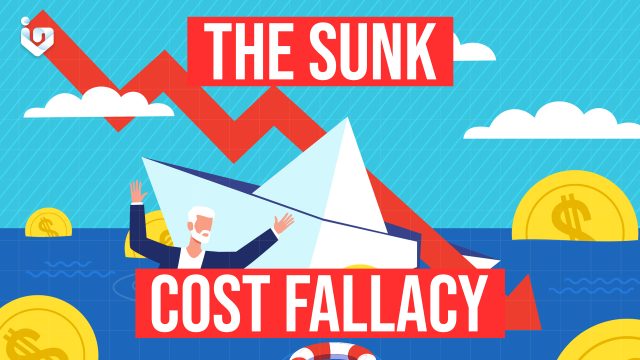The sunk cost fallacy is a cognitive bias that makes you stick to a losing investment or project. This is even when it would be better to cut your losses and move on. The sunk cost fallacy occurs when you consider the money, time, or effort that you have already invested in something as a reason to continue investing, regardless of the future prospects or outcomes.
The sunk cost fallacy can lead to irrational and suboptimal decisions, as it prevents you from evaluating the current situation objectively and rationally. Instead of focusing on the potential costs and benefits of your future actions, you are influenced by the past costs that you cannot recover.
Examples of the Sunk Cost Fallacy
The sunk cost fallacy can affect your investment decisions in various ways. Keeping a stock that is declining in value is a common scenario. Hoping that it will rebound instead of selling does little to help investors. Sometimes, people even tend to double down on that investment for no good reason.
In general life, it can also be referred to as the “economics of spilled milk.” We tend to worry too much about wasting things we’ve spent resources on. Often, this comes to the point of making suboptimal decisions.
Why Does the Sunk Cost Fallacy Happen?
The sunk cost fallacy happens because of several psychological factors, such as:
– Loss aversion: Loss aversion is the tendency to prefer avoiding losses over acquiring gains. People feel more pain from losing something than pleasure from gaining something of equal value. Therefore, they are reluctant to accept losses and try to avoid them at all costs.
– Commitment bias: Commitment bias is the tendency to remain consistent with one’s previous actions or beliefs, even when they are contradicted by new evidence or information. People feel the need to justify their past choices and actions, and to maintain a positive self-image and reputation.
– Escalation of commitment: Escalation of commitment is the tendency to increase one’s investment or involvement in a situation, despite negative feedback or outcomes. People feel the pressure to prove themselves right, to avoid wasting their previous investments, or to avoid admitting failure.
How to Overcome the Sunk Cost Fallacy in Investing
Overcoming the sunk cost fallacy in investing can be challenging, but the following strategies can help you:
– Ignore the past costs: The past costs that you have already incurred are irrelevant to your future decisions. They are sunk costs that you cannot recover, no matter what you do. Therefore, you should ignore them and focus on the future costs and benefits of your actions.
– Evaluate the opportunity cost: The opportunity cost is the value of the next best alternative that you give up as a result of your decision. By continuing to invest in a losing situation, you are missing out on other opportunities that could be more profitable or beneficial. Therefore, you should evaluate the opportunity cost of your decision and compare it with the expected value of your current investment.
– Learn from your mistakes: The sunk cost fallacy can also be a learning opportunity, if you are willing to admit your mistakes and learn from them. Instead of being defensive or stubborn, you should be open-minded and flexible. You should analyze your decision-making process, identify the sources of error or bias, and correct them for the future.
In Life and in Trading
Always make sure to have an objective view of the situation. Try to assess the costs and benefits of each decision. Just because you’ve already invested time or money in something, doesn’t mean you need to continue to do so.

